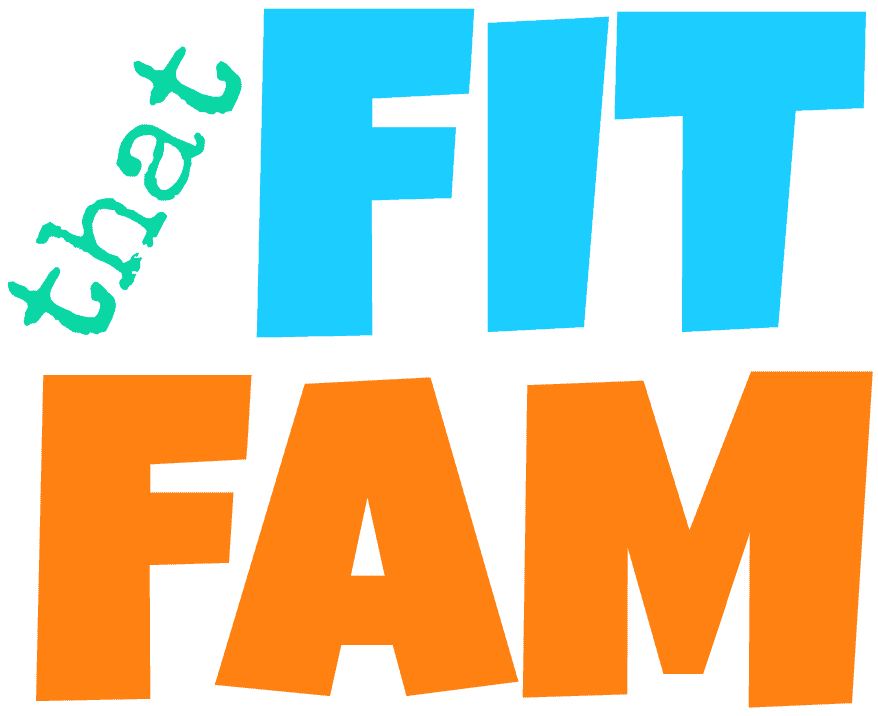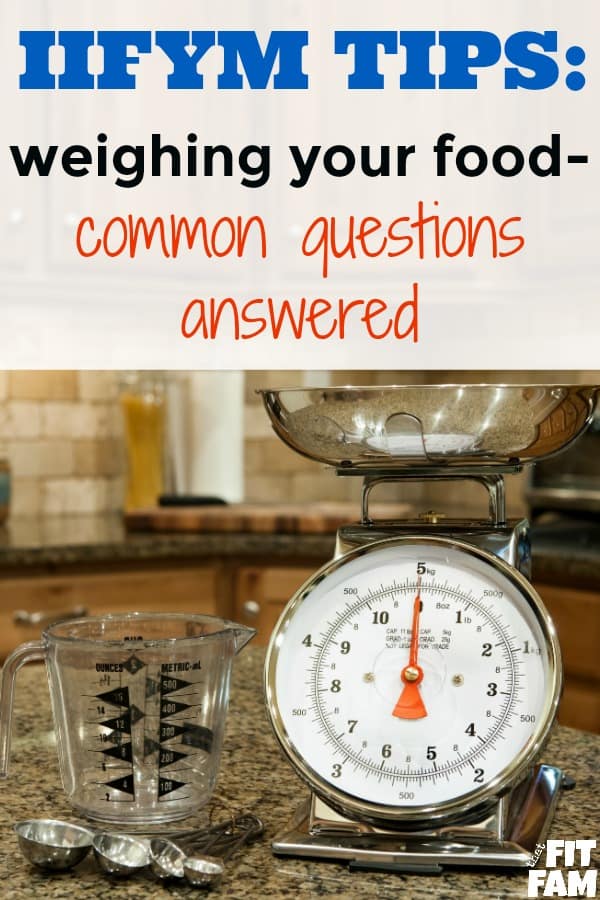By now a lot of people have heard about counting macros (aka IIFYM or flexible dieting). It is becoming more and more popular and we love it!
Counting macros is basically a very detailed way of counting calories. You track the macro nutrients that make up the food you are eating instead of just their calories alone.
It sounds overwhelming, but it’s actually pretty easy. Keep reading and I will go over all the basics of counting macros for beginners!

We dispel a lot of diet myths over here at That FIT Fam because a lot of the “fad diets” and “weight loss secrets” are just bogus.
The fact of the matter is that a lot of people are unsuccessful when it comes to weight loss, and instead of taking a hard look at what foods they’re eating and how much, they would rather believe there’s some secret key that they’re missing. And believe me, the fitness industry LOVES to exploit that!

What weight loss really comes down to is calories in vs calories out.
Calories are made up of 3 macro nutrients: fat, carbs, and protein. Each of these macro nutrients has a specific role for your body.
Side note: alcohol is it’s own macronutrient, but is not necessary for your body to function. We go into alcohol macros in this post.
Fad diets that ask you to cut out one specific macro nutrient may work initially, but they are not sustainable because your body NEEDS all three. In fact, eighty-five percent of dieters will gain that initial weight loss back within the year! (source)
The best way to lose weight & keep it off is to eat foods that meet your body’s macro nutrient needs so that it can function at it’s best without feeling deprived.
Counting Macros for Beginners:
Step One: Determine goals
Your first step is going to be to figure out your goal. Do you want to lose weight? Gain weight? Or maintain?
After deciding your goal, you need to figure out your TDEE (total daily energy expenditure). This is your BMR plus any calories you burn through physical activity. You can definitely do this manually, but I love this TDEE calculator.
If your goal is to lose weight, take this number and subtract 250-500 calories.
Taking off 250 calories will give you a caloric deficit of 1750 calories per week, which is 1/2 pound loss. If your goal is to lose 1 pound, subtract 500 calories.
While you can healthily lose 2 pounds a week, it is not recommended to reduce your calories by more than 500 =)
If your goal is to maintain keep your calories the same as your TDEE.
To gain weight, you would need to increase your calories.

How to divide up your calories:
I go over this in detail in my post on how to adjust your macros, but let’s get into the basics.
Protein: roughly .8- 1 g per pound of bodyweight (obese use 1 g per pound of lean body mass)
Fats: .4 g per pound of bodyweight minimum OR 30% of daily calories
Carbs: whatever’s left (you’ll have lower carbs in a deficit than when eating in a surplus.)
So let’s say I weigh 140 pounds and have a goal to eat 2,000 calories per day. I need between 112-140 g to come from protein and 56 g fat minimum.
I personally would stick with the lower end of the protein goal because it will be more manageable. So let’s go with 115 g protein and 56 g fat.
Now to figure out carbs I first need to see how many calories I have left. To do this I need to convert my protein & fat grams to calories and subtract that from my total calories.
To convert those calories into grams you need to know this:
Protein = 4 calories per 1 gram
Carbs = 4 calories per 1 gram
Fats = 9 calories per 1 gram
For the example above multiply 115 g protein by 4 to get 460 calories and 56 g fat by 9 to get 504 calories. Subtract these numbers from our calorie goal of 2000 and you are left with 1036 calories to come from carbs.
Convert his to grams by dividing 1036 by 4 to get 259 g carbs.
The biggest misconception is that these numbers are rigid. You can play around with these. Remember earlier when I said calories in calories out determines weight loss? As long as you hit your overall calorie goal you will not sabotage your goals.
If you find that 115 g protein isn’t enough because you’re left feeling hungry, adjust it! Move your protein goal to the higher end of that range and lower your carbs accordingly.
If the bare minimum fats requirement (.4 g per pound) is too hard to hit, up it to 30% of your calories and lower your carbs accordingly!
The reason we track is to make sure we are getting enough of each macronutrient and not favoring only fats or only carbs.
Hitting that protein goal (especially when in a caloric deficit) is so important. This is the key to targeting weight loss from fat instead of a mix of fat & muscle mass.
By hitting your protein goal & adding in some resistance training, you are preserving as much of that muscle as possible. This will help you achieve that lean look vs just “skinny fat.”
You don’t have to calculate your macros.
I know I just explained all the math, but truth is. You can just go onto IIFYM.com and use their FREE macro calculator. I’m the type of person who likes to calculate it myself, but you don’t have to. Their website will also recommend you buy their “custom blueprint” but it’s not necessary at all.
Clean eating vs IIFYM.
Counting macros is also called flexible dieting because it is flexible. If you really want a candy bar or some french fries you can eat it as long as it fits within your allotted macros for the day. But, once you really start tracking you will realize that you CAN’T eat like that all day long otherwise you will be left hungry at the end of the day. Junk food is just way too calorie dense. It’s either got way too much fat or way too many carbs.
Personally, I’d rather have my day comprised of several large meals that fill me up than just a bag of m&ms and a protein shake. Obviously that’s a little bit of an exaggeration, but you get my point: the cleaner you eat the more you can eat (most of the time).
Incorporating clean eating with counting macros is the best way to get to your goals. Why? Because you get the benefits of the nutrient dense food with the flexibility of counting macros for when you have a craving that you just can’t shake. When you choose to just eat clean without tracking, it can feel very restrictive which often leads to binge eating.
How to keep track of your macros:
The most popular way to track your macros is to use the My Fitness Pal app. Here’s a tutorial on some great hacks for the app that really help you get the most of it!
One warning, My Fitness Pal will try to calculate macros for you, don’t let it. It is notorious for giving unrealistic, low macro/calorie goals. Avoiding this and instructions for setting your own macros in the app is in the tutorial I linked above =)
Weigh your food. It sounds tedious, but do it. One serving of Kodiak Cakes Pancake Mix is a 1/2 cup or 53 g. If I use a 1/2 c measuring cup and pack in the pancake mix & log it as 1 serving I am way off. It ends up being about 1 1/2 servings.
Using a food scale like this one that measures to the gram will keep you on target. The people who count their macros and aren’t successful either had their macros calculated incorrectly or don’t weigh their food. It’s that simple.
Weighing your food is actually not as inconvenient as it sounds, trust me. Here are some of our fave tips on weighing food that definitely make it easier. Want to eat straight out of the jar? We’ve got that covered & more!
By the way, that cheap food scale is the only money you need to spend on this “diet” (other than food).
Which foods to track. Short answer: All of them.
A common question people ask is about net carbs. Do you only track net carbs or all carbs? If you ate it, you track it. You definitely want to be getting in fiber, but those are not free carbs so log them.
Okay, that covers the basics. It’s sounds harder than it is. When people first start out, the hardest part is just hitting your goals for each macro nutrient. Oftentimes they will be under on protein and over on fats or carbs. It’s normal.
After a week you will get the hang of it and understand what combinations of meals works best for your numbers. I need to have around 25 grams of protein, 5 times a day. So I try to make every meal & snack have a full serving of protein. I structure my meals around my protein goal.
Don’t forget, there is definitely a learning curve that comes with this, so be patient. Like I mentioned earlier, we’ve been doing this for 4 years!
What I’ve come to learn is that this diet is actually way more flexible than it seems. In fact, I touch on this and 24 other IIFYM tips to help set you up for success right from the beginning here.
Think lifestyle change.
IIFYM is not meant to be a quick fix. It will completely change the way you look at food. This is a diet plan that is meant to take time (slow & steady wins the race). Because of this, you will run into holidays, birthdays, special occasions, and even just the typical Friday night. IIFYM accounts for all of that. There are several strategies I’ve learned to help me so that I can eat out while tracking and still hit my goals. There are also tips I’ve implemented so that I can stay on track even with a family.
Our experience with IIFYM
We have been living the IIFYM lifestyle for about 4 years now. I, personally, have lost baby weight twice using this method. I lost the 40 pounds I gained with my first and then the 25 pounds I gained with my second.
When I hit my macros, my work outs are easier and I feel more energetic. My husband feels the same. He gets up for work around 5 am. When he’s hitting his macros, he needs less/no energy drinks! While I can’t guarantee that you will lose weight or feel better overall, I would be surprised if you didn’t.
One more thing…
I would definitely say one of my favorite things about this lifestyle are the people who follow it. Check out the support groups on Facebook. These people are science based, logical thinkers. They are so quick to disprove any fad diet.
No one who counts macros is ever going to tell you that you’re not seeing results because you forgot to take your fat burner pill. They will call you out on your BS. Did you weigh everything? Did you weigh condiments? They will offer macro checks (go over your calculations and double check them). They will share the BEST before & afters. They will help you learn the basics of weightlifting. And most importantly, they will offer support when you need it.
If you need help losing weight, building muscle, or anything in between, give macros a chance.
Originally published on 9/2017, revised & updated on 8/2021






DAWN D RIGGS
Wednesday 3rd of February 2021
I am so grateful for this post. I am struggling with my health because of different diets that have apparently destroyed my thyroid. I am currently seeing a doctor who is also holistic and she has me on protein,fat, and carb diet to fix my health. I went 5 years with my thyroid being misdiagnosed because of lazy doctors. During that 5 years, I had a pregnancy at 41 years old. Once my youngest was born, I was 41 and HUGE. Once I made up my mind to take the weight off; I went the WRONG direction with another doctor who did NOT care about me. I was put on diabetic meds and an appetite suppressant and I lost 93 lbs in 7 months. This literally almost cost me my life. My gall bladder became inflamed and enlarged and was putting pressure on my heart; I had an emergency operation where they gave me something that stopped my heart. May 15th 2016, at 43 years old, I died on the table. They cracked my sternum bringing me back. I am so GRATEFUL they cracked my sternum. My children are 19 & 6 -- I have a lot of LIVING to do and a lot to see. You may not realize how much this post means to people, but for people like me; it is HOPE. I am JUST now learning how to care for my health. THANK YOU FOR SHARING YOUR KNOWLEDGE!!!!!!!!!!!
Lexi @ That Fit Fam
Saturday 20th of March 2021
Thank you so much for your comment Dawn! Your story is amazing and inspiring. I am so happy to hear that you are taking control of your health and were able to find a great doctor and that this article was helpful! I truly wish you the best. I apologize for the slow response, it's been difficult to find time to hop on here with our current virtual school situation...
How to adjust your macros - That Fit Fam
Sunday 9th of June 2019
[…] my beginner’s post, I briefly went over a few macro splits that are based on percentages. That is a great starting […]
25 Tips for success with Macros - That Fit Fam
Monday 27th of May 2019
[…] New to tracking? Read our beginners post first! […]
Lose weight while breastfeeding - That Fit Fam
Saturday 18th of May 2019
[…] eating. It is more complicated than calories in and calories out, which is why I recommend counting macros. Maybe you’re consuming too much fat and too little protein. Adjusting your macros could be […]
IIFYM Tips- how to weigh your food - That Fit Fam
Wednesday 8th of May 2019
[…] Counting Macros for Beginners […]